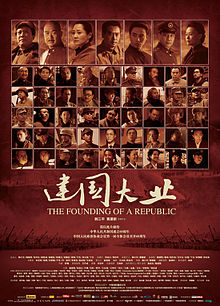My wife and I watched the new Shaolin during the Chinese New Year holidays. As my wife commented, it looks like a shoo-in for the Hong Kong film awards. For my part, while it’s production values are undeniably sky high and it has decent kung fu, the Buddhist philosophy is conveyed is far too blunt and heavy-handed a manner. I tend to agree with this reviewer’s take on it being a self-indulgent extravaganza. Since it was made with the close cooperation of the real Shaolin temple, it’s no surprise that the temple is portrayed in excessively reverent terms.
For anyone curious what the real Shaolin temple as it exists now is like, this article from the National Geographic magazine is much more interesting. Most of it is a very respectful account of the last respects paid to a Shaolin master, Yang Guiwu, as well as a meeting with his most famous student, Shi Dejian. It’s quite amusing how the modern world has managed to intrude into the world of ancient martial arts.
Shi, having decided that the Shaolin monastery has become too busy and too worldly for his purposes, has retreated to a more secluded and difficult to access mountaintop where he has built his own monastery, but as he recounts, his fame is such that even this does not dissuade admirers and challengers. Within the space of a week, he has had to entertain a television crew who had brought along a professional mixed martial arts fighter to challenge him, a research team from Hong Kong University who wanted to study how his meditation regimen has affected his brain activity and a Chinese Communist Party official who wanted him to cure his brother’s diabetes.
The article is too polite to criticize the Shaolin temple too harshly but it’s hard to shake the impression that the writer is at least disdainful. He describes how the temple was, contrary to the portrayal in the new film, essentially a wealthy estate with its own private army and its has frequently being criticized throughout its history for its riches and its taste for luxurious furnishings. Today, the various projects the temple is officially involved in include television and film ventures, an online store selling Shaolin branded products, touring kung fu troupes and a plan for Shaolin franchises abroad, including one in Australia. It appears that many of the workers at the temple, wearing robes and bearing shaved heads, aren’t even monks at all but employees paid to look the part.
Such is the importance of the kung fu teaching industry that the city of Dengfeng is now full of competing martial arts academies who pay commissions to touts to welcome new arrivals and bring them to their schools. The masters interviewed for the article even bemoan how high kicks and acrobatics aren’t part of Shaolin kung fu at all, but students expect them and so many academies incorporate these moves into their repertoire. So it turns out that even at Shaolin itself, traditional Shaolin kung fu is in danger of being forgotten as students learn what is effectively the movie version of kung fu instead.

